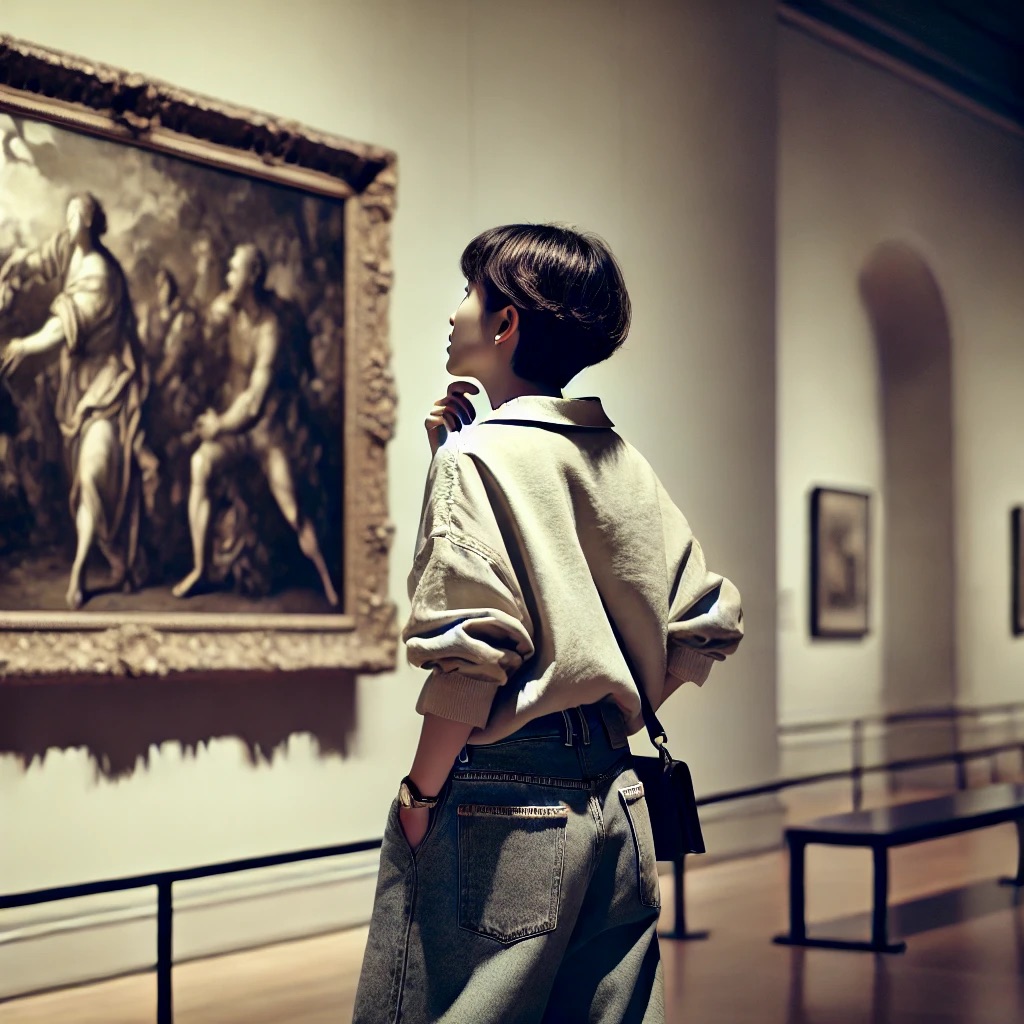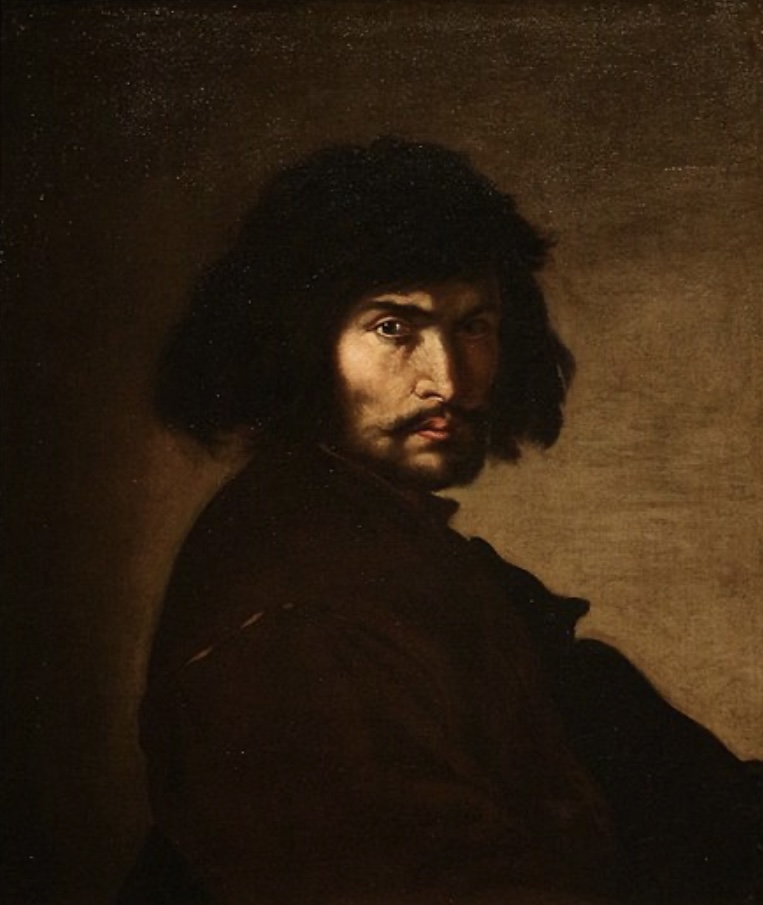
Rosa was also a master of depicting scenes of bandits, soldiers, and other adventurous figures, often conveying a sense of romantic heroism and mystery. In addition to landscapes, he painted historical, mythological, and religious subjects, always with a distinctive, bold style. Rosa was also a satirical poet and playwright, and his rebellious personality often put him at odds with the artistic establishment of his time. His work had a significant influence on later Romantic artists.
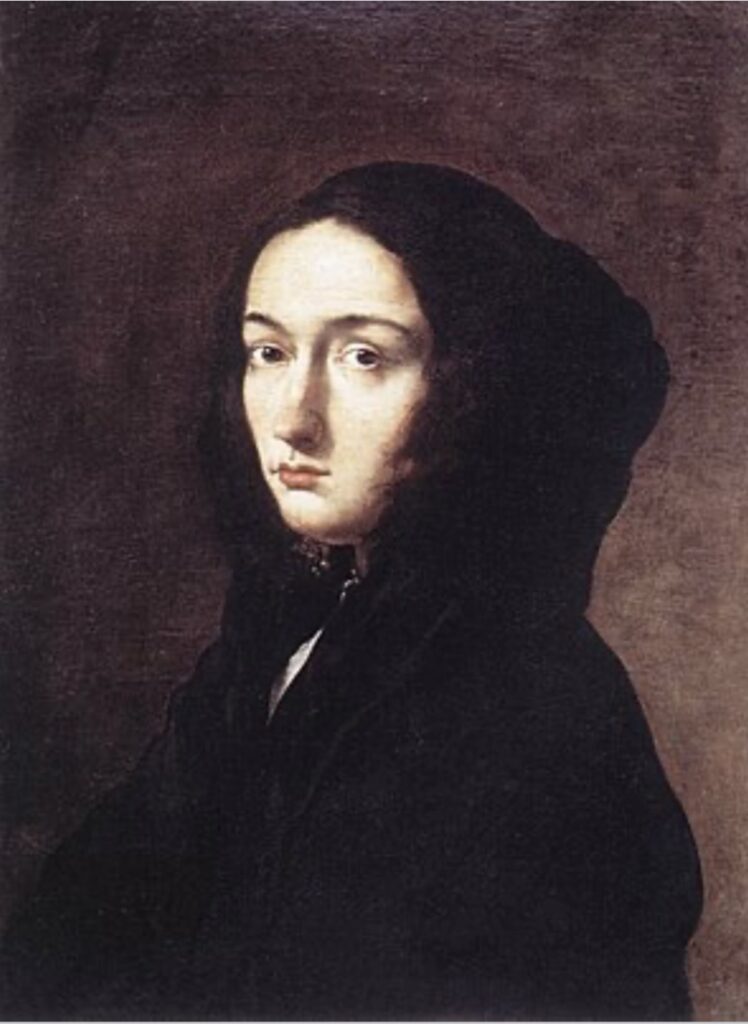
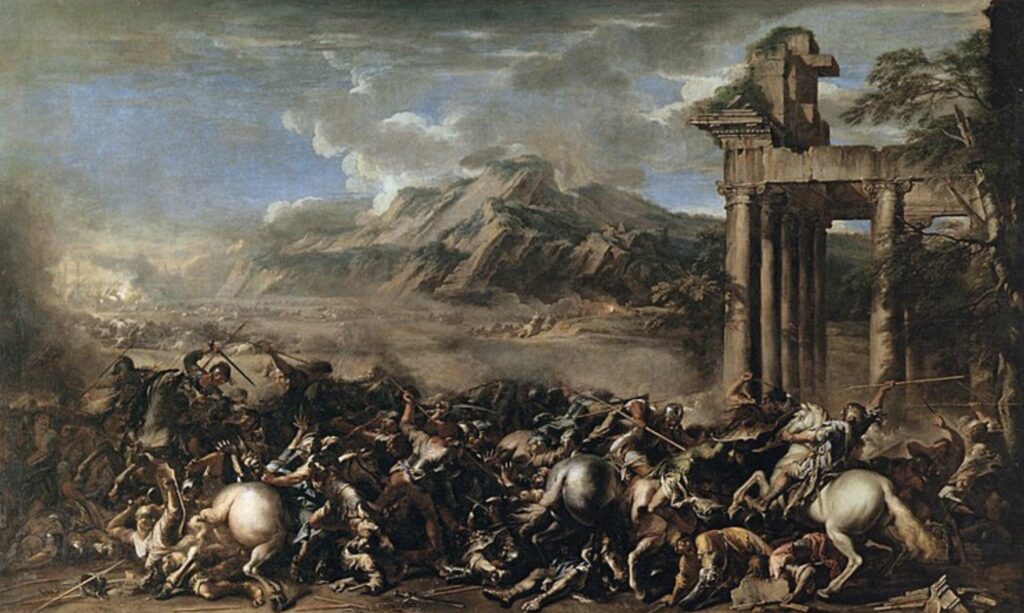
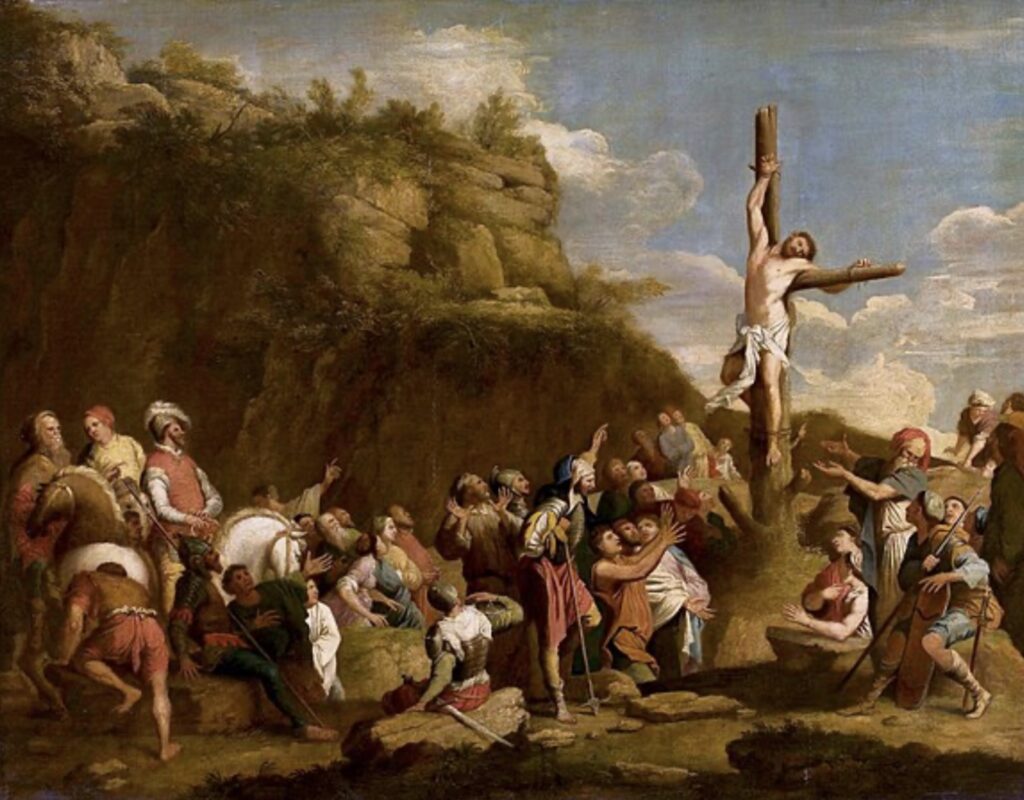
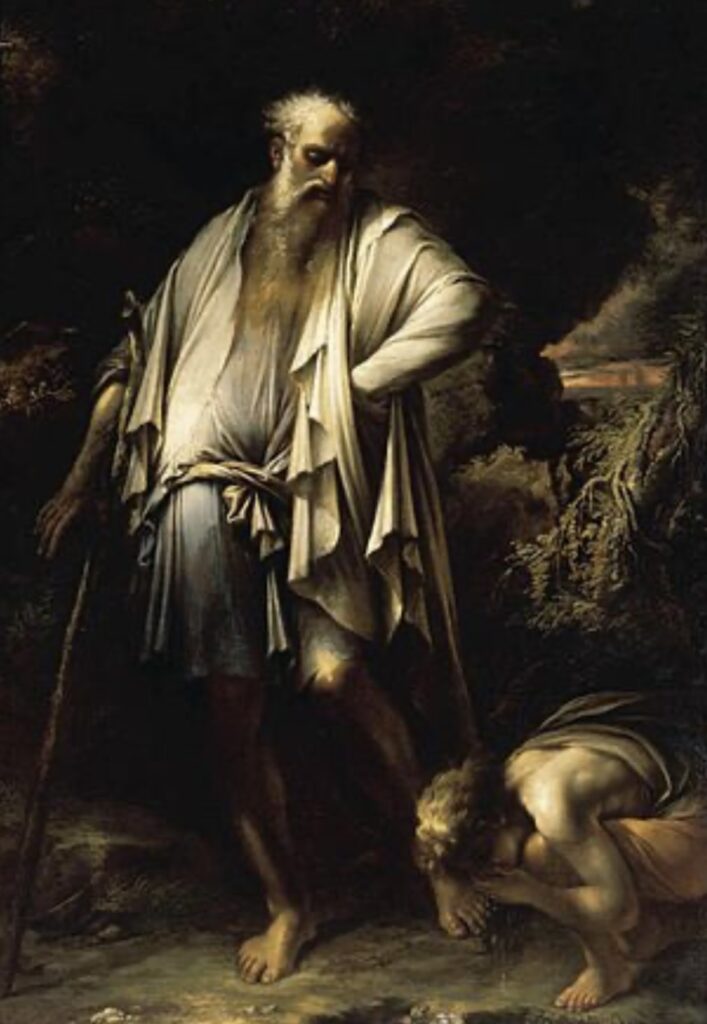
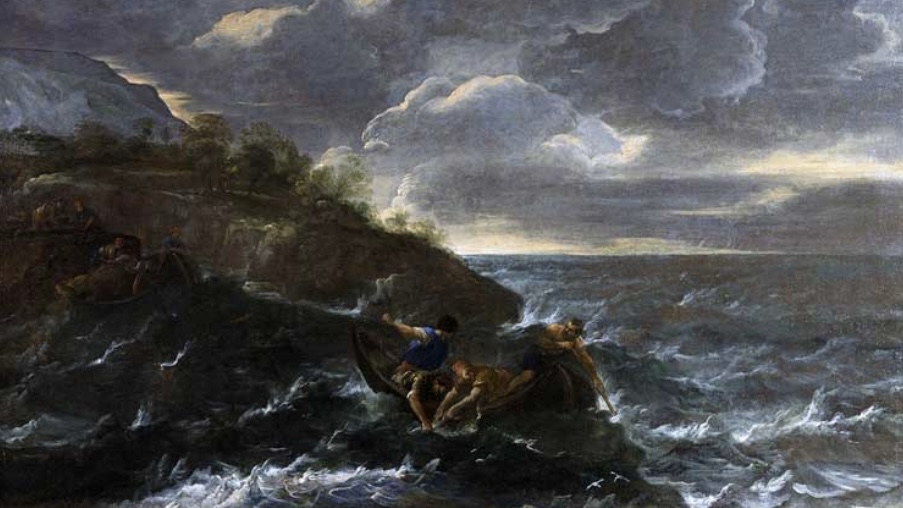
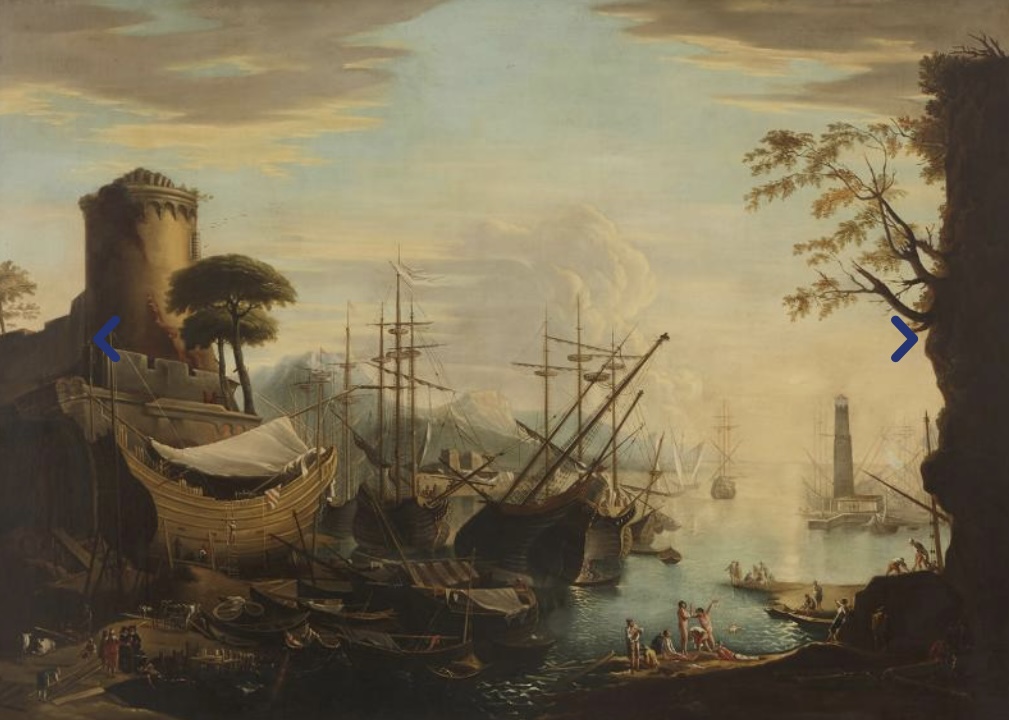
Salvator Rosa’s paintings are distinguished by several key characteristics and special features that set him apart from other artists of the Baroque period:
- Dramatic and Wild Landscapes:
- Rosa’s landscapes are notable for their dramatic and often desolate scenery. He frequently depicted untamed nature, with rugged mountains, stormy skies, dense forests, and turbulent seas. These elements create a sense of awe and the sublime, emphasizing nature’s power and unpredictability.
- Theatrical Lighting and Atmosphere:
- He skillfully used chiaroscuro, the contrast between light and dark, to heighten the dramatic effect of his scenes. This technique helped create a moody, atmospheric quality, often lending an eerie or mysterious tone to his work.
- Unconventional Subjects:
- Unlike many of his contemporaries who focused on religious and mythological themes, Rosa often chose unconventional subjects. His works featured bandits, soldiers, hermits, and witches, exploring themes of adventure, danger, and the supernatural. This choice of subject matter set him apart as a painter who sought to evoke emotion and curiosity in the viewer.
- Expressive Figures:
- The figures in Rosa’s paintings are often portrayed with dynamic and expressive poses. His characters are not mere decorations but active participants in the narrative, contributing to the overall mood and story of the painting.
- Symbolism and Allegory:
- Rosa incorporated symbolic elements and allegorical content into his works. He often used these to comment on human nature, society, and the world around him. For example, his painting “The Allegory of Fortune” critiques the arbitrary nature of fate and fortune.
- Rough Brushwork:
- His brushwork is characterized by a certain roughness and spontaneity. This technique gives his paintings a lively, energetic feel, distinguishing them from the more polished works of other Baroque artists.
- Dark and Earthy Palette:
- Rosa often employed a dark and earthy color palette, with deep browns, greens, and blues dominating his scenes. This choice of colors enhanced the somber and mysterious atmosphere of his paintings.
- Emotion and Intensity:
- Rosa’s works are imbued with a strong sense of emotion and intensity. Whether depicting a calm, reflective scene or a chaotic, stormy landscape, his paintings evoke a powerful emotional response, reflecting his own passionate personality.
Overall, Salvator Rosa’s paintings stand out for their originality, boldness, and emotional depth. His unique style and subject matter have made him a distinctive and influential figure in the history of art.
Salvator Rosa’s distinctive style and thematic choices significantly influenced other artists and later artistic movements, particularly during the Romantic period. Here are some key aspects of his influence:
- Romanticism:
- Rosa’s dramatic landscapes and the sense of the sublime in his work prefigured the Romantic movement. Artists like Caspar David Friedrich, J.M.W. Turner, and Francisco Goya drew inspiration from Rosa’s use of rugged nature and atmospheric effects to evoke emotional responses. The Romantic emphasis on individualism, emotion, and the sublime in nature can be seen as a continuation of themes explored in Rosa’s paintings.
- Landscape Painting:
- His unconventional approach to landscape painting, focusing on wild and untamed nature, influenced later landscape artists. This influence is evident in the works of painters who embraced more naturalistic and emotive portrayals of nature, moving away from the classical ideals of harmony and order.
- Dark and Dramatic Themes:
- Rosa’s fascination with dark, dramatic, and often unconventional subjects found resonance in the works of later artists who explored similar themes. His depictions of bandits, hermits, and supernatural scenes paved the way for artists interested in the gothic, macabre, and the mysterious.
- Baroque and Rococo Artists:
- Even within his lifetime, Rosa’s bold style and choice of subjects influenced his contemporaries and followers. Some Baroque and Rococo artists, attracted by his dramatic flair and thematic boldness, incorporated elements of his style into their own work.
- Narrative and Allegorical Painting:
- Rosa’s use of allegory and symbolism to comment on human nature, society, and politics influenced later artists who sought to imbue their work with deeper meanings and social commentary. His approach encouraged a narrative style of painting that extended beyond simple depictions to explore complex ideas and emotions.
Overall, Salvator Rosa’s work helped broaden the scope of what was considered acceptable subject matter and style in art. His legacy is particularly evident in the Romantic movement’s focus on emotion, the sublime, and the exploration of darker aspects of the human experience. His influence can also be seen in the continuing fascination with nature’s power and mystery in art.
Salvator Rosa created numerous notable works throughout his career, many of which are held in prominent museums and collections worldwide. Here are some of his most famous paintings and their locations:
- “The Temptations of St. Anthony”
- Location: The National Gallery, London, UK
- This painting depicts the temptations faced by St. Anthony in the wilderness, showcasing Rosa’s skill in creating dramatic and expressive scenes.
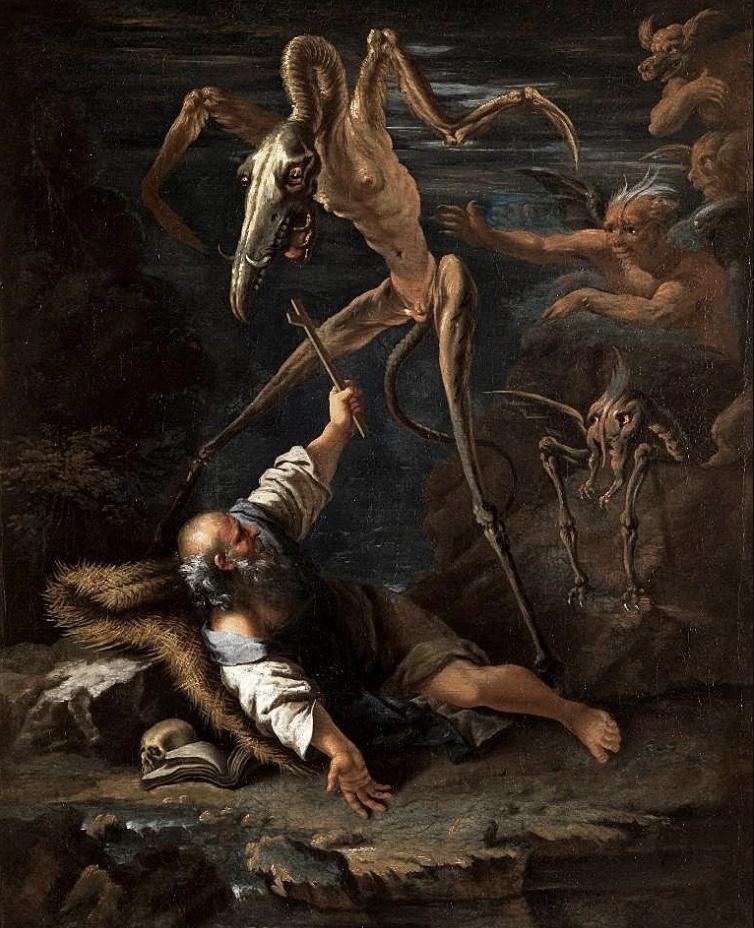
Key Elements and Interpretation:
1. Saint Anthony:
• In the foreground, Saint Anthony is depicted as an elderly man with a white beard, dressed in simple clothing. He appears to be in a state of distress or fear, gesturing upwards as if to ward off the demonic figures surrounding him. His expression and posture convey a sense of struggle and desperation, emphasizing the intensity of his spiritual trial.
2. Demonic Figures:
• The painting is filled with a variety of grotesque and fantastical creatures. The central demon, towering over Saint Anthony, has an elongated, skeletal form with a horned, animal-like skull for a head. This monstrous figure, along with other demons, seems to be attacking or taunting the saint. These creatures are symbolic of the temptations and challenges that Saint Anthony faced, representing the darker forces that seek to distract and corrupt the faithful.
3. Symbolism and Themes:
• The demons’ bizarre and frightening forms are symbolic of the inner demons and sins that one must confront and overcome. The scene represents the spiritual warfare between good and evil, a common theme in Christian iconography. The skull near Saint Anthony’s hand, often a memento mori, serves as a reminder of mortality and the transient nature of earthly life, reinforcing the idea of spiritual perseverance.
4. Use of Light and Shadow:
• Rosa uses chiaroscuro to create a dramatic effect, with strong contrasts between light and dark areas. The dark, almost otherworldly background contrasts with the illuminated figure of Saint Anthony, highlighting his importance in the scene and emphasizing the supernatural elements.
5. Emotional Tone:
• The painting conveys a sense of fear and tension, capturing the emotional and psychological torment that Saint Anthony experiences. The chaotic arrangement of the demons and the saint’s defensive posture enhance the feeling of overwhelming adversity.Overall Interpretation:
Rosa’s imaginative portrayal of the demonic forces and the expressive depiction of Saint Anthony contribute to the painting’s powerful impact, making it a vivid representation of the timeless struggle between good and evil.
- “The Witch of Endor”
- Location: Musée du Louvre, Paris, France
- This work illustrates the biblical story of the Witch of Endor, who summons the prophet Samuel’s spirit. It is notable for its dark and eerie atmosphere.
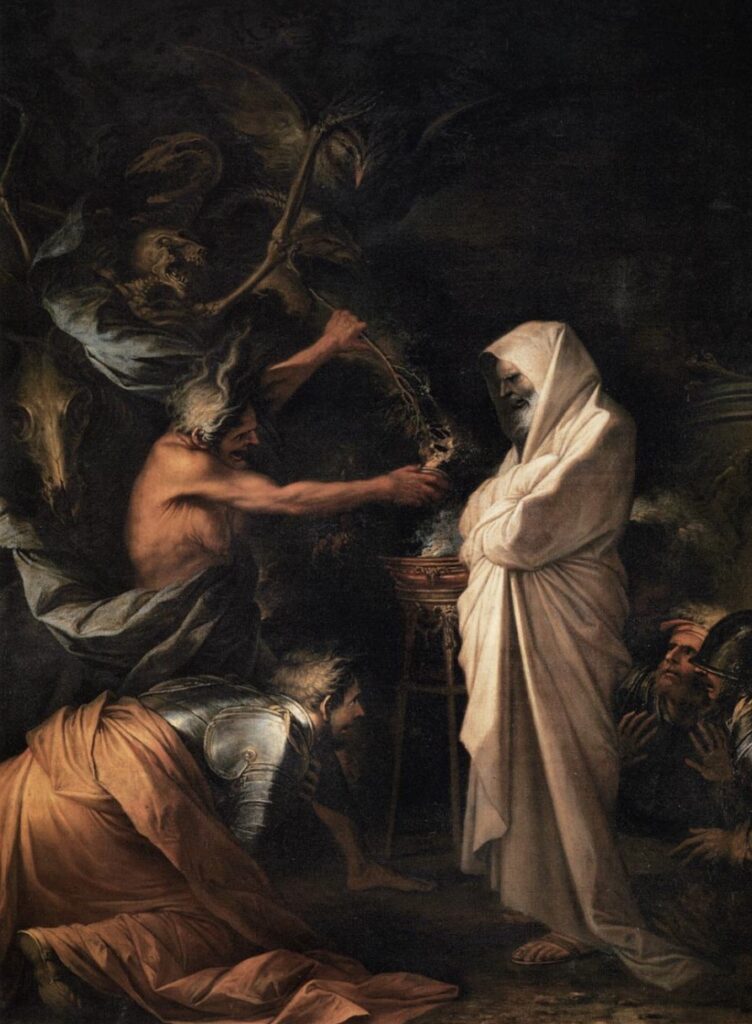
Key Elements and Interpretation:
1. Central Figures:
• King Saul: The figure kneeling and looking up in a mixture of fear and reverence is King Saul. He appears distressed and desperate, emphasizing the gravity of the situation. Saul’s posture and expression reflect his internal turmoil and fear of the coming battle and his fate.
• The Witch of Endor: The figure standing with an intense and mystical gesture is the Witch of Endor. She is depicted performing the act of summoning, likely holding some magical implement or making a symbolic gesture. Her posture and expression are focused, embodying the mystical and arcane nature of her craft.
• The Shade of Samuel: The ghostly figure draped in white is the summoned spirit of the prophet Samuel. His appearance is calm and authoritative, contrasting with the more dynamic and emotional figures around him. Samuel’s presence is solemn and foreboding, as he delivers a grim prophecy to Saul.
2. Atmosphere and Setting:
• The painting uses dark, shadowy tones to create an eerie and mystical atmosphere. The use of chiaroscuro enhances the dramatic effect, with light highlighting the key figures and the spectral form of Samuel. The dark background and limited light sources contribute to the mysterious and supernatural theme.
3. Symbolism:
• Necromancy and Forbidden Knowledge: The act of summoning the dead, as depicted by the Witch of Endor, represents the pursuit of forbidden knowledge and the consequences of defying divine law. In the biblical narrative, Saul’s act is seen as a transgression, leading to his downfall.
• Prophecy and Fate: The appearance of Samuel’s spirit serves as a symbol of prophecy and the inevitability of fate. Samuel’s message to Saul is one of doom, predicting his defeat and death, which underscores the themes of divine judgment and the consequences of disobedience.
4. Emotional Tone:
• The painting conveys a sense of tension and foreboding. The intense expressions and gestures of the figures reflect the gravity of the moment, as Saul faces the reality of his impending fate. The calm, spectral presence of Samuel adds a layer of solemnity to the scene.Overall Interpretation:
“The Witch of Endor” by Salvator Rosa is a powerful depiction of a biblical story that explores themes of fate, divine judgment, and the pursuit of forbidden knowledge. The painting captures the moment of supernatural revelation with dramatic intensity and emotional depth. Through its dark, atmospheric setting and expressive figures, the artwork conveys the weight of Saul’s actions and the ominous consequences foretold by Samuel’s ghostly presence. This work reflects Rosa’s interest in dramatic, mystical, and philosophical subjects, and his ability to convey complex narratives through his art.
- “Democritus in Meditation”
- Location: Musée du Louvre, Paris, France
- A depiction of the ancient Greek philosopher Democritus, known as the “laughing philosopher.” The painting reflects Rosa’s interest in philosophy and intellectual themes.
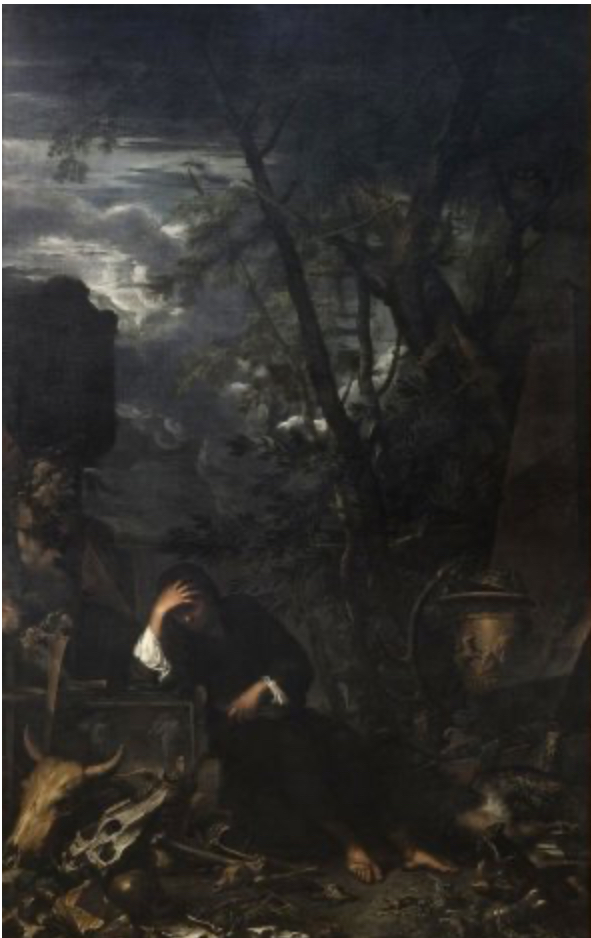
Key Elements and Interpretation:
1. Democritus:
• The central figure, Democritus, is portrayed seated in a contemplative pose, often with one hand supporting his head, a common gesture signifying deep thought or melancholy. This pose indicates a state of profound meditation, as he reflects on the nature of the world and the universe.
2. Surroundings and Atmosphere:
• The setting is dark and somber, with a desolate landscape that includes broken objects, skulls, and other symbols of mortality and decay. These elements emphasize the transient nature of human life and the material world, resonating with Democritus’ philosophical views on the impermanence of things.
3. Symbols of Knowledge and Vanity:
• Various objects scattered around, such as books, scientific instruments, and animal skulls, symbolize knowledge, science, and the study of nature. The presence of a skull, a common memento mori, serves as a reminder of death and the fleeting nature of life. Additionally, these symbols may critique the vanity of human pursuits and the limitations of human knowledge.
4. Contrast and Lighting:
• Rosa uses chiaroscuro to create a strong contrast between light and shadow, highlighting Democritus while leaving much of the background in darkness. This technique draws attention to the philosopher’s introspective state and the intellectual exploration he embodies.
5. Mood and Emotional Tone:
• The painting conveys a mood of melancholy and contemplation. It reflects on the existential aspects of human life, the pursuit of wisdom, and the realization of life’s inherent uncertainties and limitations.Overall Interpretation:
The painting serves as both a tribute to the intellectual legacy of Democritus and a broader reflection on the philosophical and existential questions that have occupied thinkers throughout history. It invites viewers to consider the deeper meaning of life and the nature of the universe, encouraging a contemplative and philosophical mindset.
- “The Conspiracy of Catiline”
- Location: Pitti Palace (Palazzo Pitti), Florence, Italy
- This painting captures a moment from Roman history, focusing on the conspiracy led by Lucius Sergius Catilina against the Roman Republic.
- “Landscape with Mercury and the Dishonest Woodman”
- Location: The Metropolitan Museum of Art, New York, USA
- An allegorical landscape featuring the god Mercury and a scene from Aesop’s fable, demonstrating Rosa’s talent for integrating narrative and landscape.
- “The Allegory of Fortune”
- Location: J. Paul Getty Museum, Los Angeles, USA
- A symbolic painting that critiques the arbitrary nature of fortune, reflecting Rosa’s philosophical and satirical interests.
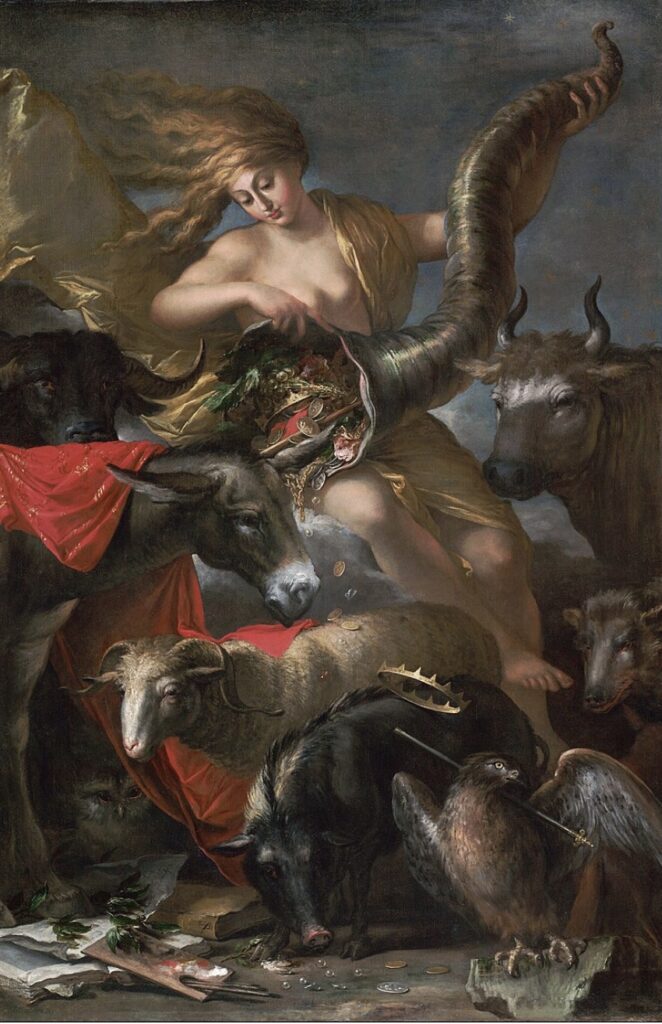
- “Aeneas and the Cumaean Sibyl”
- Location: National Gallery of Victoria, Melbourne, Australia
- This work depicts the hero Aeneas and the prophetess Sibyl, drawing from Virgil’s “Aeneid.”
- “The Baptism of Christ”
- Location: Fitzwilliam Museum, Cambridge, UK
- A religious painting showcasing Rosa’s approach to sacred subjects, with a focus on dramatic expressions and settings.
These paintings illustrate the diversity of Salvator Rosa’s subject matter and his skill in both narrative and landscape painting. Many of his works are characterized by their dramatic intensity, use of chiaroscuro, and expressive figures.
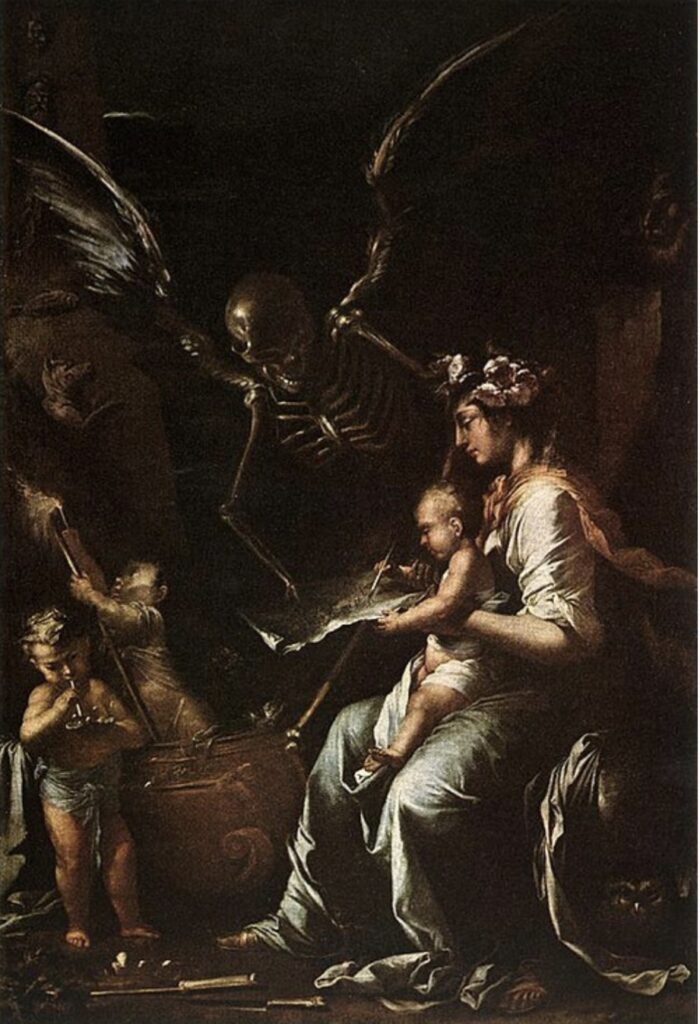
In Salvator Rosa’s painting “Human Fragility,” the artist explores themes of mortality and the transient nature of life through a rich allegorical composition. The painting features several symbolic elements and figures:
1. Central Figure (Mother and Child):
• A woman, possibly an allegorical figure representing Humanity or Life, is seated and holding a child. The child holds a quill and appears to be writing on a sheet of paper. This act of writing may symbolize the transient nature of life and the legacy one leaves behind.
2. Skeleton Figure (Death):
• A large, ominous skeleton with wings looms over the scene, a common representation of Death. The skeleton’s presence emphasizes the inevitability of death and the fragility of human existence. Its wings might suggest the swift passage of time or the inescapable reach of death.
3. Putti (Cherubs):
• To the left, two putti are engaged in various activities. One holds an object, possibly an hourglass, symbolizing the passage of time. The other putto seems to be lighting a fire or candle, a symbol of life that can be extinguished at any moment. The putti, often associated with innocence, contrast with the darker themes of mortality and decay.
4. Memento Mori Symbols:
• Various objects in the painting serve as memento mori, reminders of death and the transient nature of earthly life. These could include the hourglass, skull, or extinguishing candle, commonly used symbols in vanitas paintings to remind viewers of life’s brevity.
5. Overall Composition and Tone:
• The painting’s dark tones and dramatic use of chiaroscuro heighten the somber mood. The interplay of light and shadow draws attention to the key symbols and figures, creating a stark contrast that underscores the themes of life and death.
6. Symbolic Objects:
• The presence of books, an inkwell, or other scholarly items might suggest the pursuit of knowledge and the intellectual aspects of human life, which are also subject to time and mortality.The painting “Human Fragility” serves as a meditation on the ephemeral nature of life. It reminds viewers of the inevitability of death and the importance of leading a meaningful life, while also encouraging reflection on the legacy one leaves behind. Through this work, Rosa communicates the universal truth of human vulnerability and the transient nature of existence.
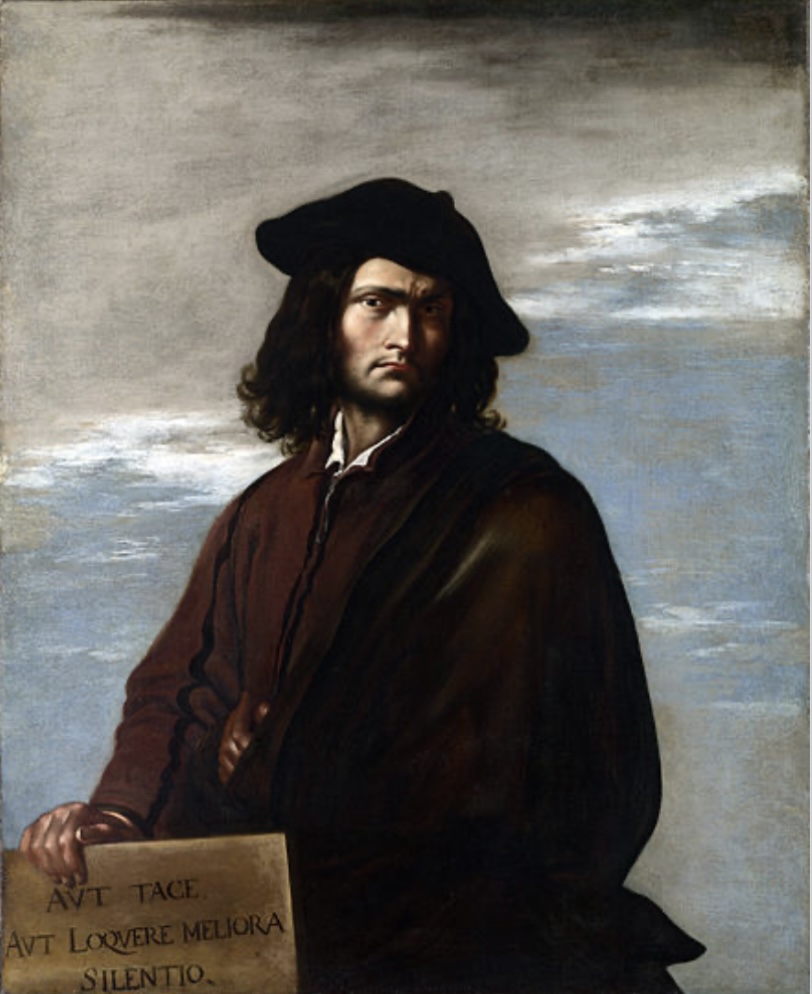
The inscription “Keep silent or say something better than silence” is a philosophical maxim that suggests the value of thoughtful and meaningful speech over unnecessary or trivial words. This aphorism encourages people to consider the impact and worth of their words before speaking, implying that silence is preferable to speaking without purpose or value.
In the context of Salvator Rosa’s painting “Philosophy” (1641), this inscription may reflect several deeper meanings:
- Wisdom and Restraint:
- The inscription underscores the importance of wisdom and restraint in communication. It implies that speaking should be done with careful consideration, and only when one has something valuable or constructive to add. This aligns with philosophical traditions that emphasize thoughtful reflection and the pursuit of truth.
- Value of Silence:
- It also suggests that silence itself holds intrinsic value. Silence can be a space for contemplation, introspection, and understanding, allowing for deeper thought and insight. In many philosophical and spiritual traditions, silence is seen as a powerful tool for achieving inner peace and clarity.
- Critique of Superficiality:
- By stating that one should “say something better than silence,” the inscription critiques superficial or empty speech. It discourages idle chatter and gossip, promoting instead a focus on meaningful and purposeful dialogue.
- Philosophical Inquiry:
- The painting, titled “Philosophy,” likely explores themes related to the pursuit of knowledge and understanding. The inscription may thus be seen as an admonition to philosophers and thinkers to use their words wisely, contributing to knowledge and enlightenment rather than confusion or distraction.
In summary, the inscription “Keep silent or say something better than silence” serves as a reminder of the power and responsibility that comes with speech. It encourages individuals to prioritize meaningful, thoughtful communication and to recognize the value of silence in fostering reflection and understanding. This message aligns with the contemplative nature of philosophy, which seeks to discern truth and meaning through careful consideration.
